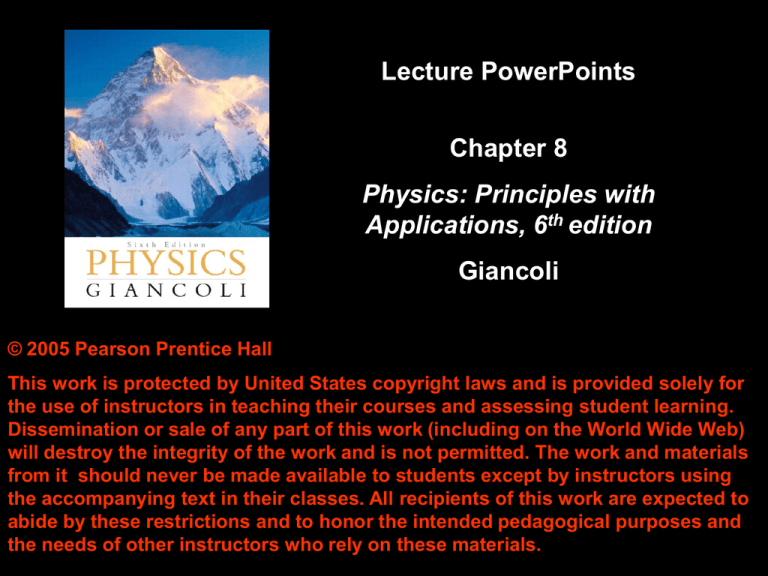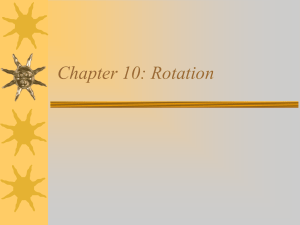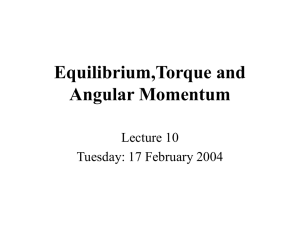
Lecture PowerPoints
Chapter 8
Physics: Principles with
Applications, 6th edition
Giancoli
© 2005 Pearson Prentice Hall
This work is protected by United States copyright laws and is provided solely for
the use of instructors in teaching their courses and assessing student learning.
Dissemination or sale of any part of this work (including on the World Wide Web)
will destroy the integrity of the work and is not permitted. The work and materials
from it should never be made available to students except by instructors using
the accompanying text in their classes. All recipients of this work are expected to
abide by these restrictions and to honor the intended pedagogical purposes and
the needs of other instructors who rely on these materials.
Chapter 8
Rotational Motion
8-1 Angular Quantities
In purely rotational motion, all
points on the object move in
circles around the axis of
rotation (“O”). The radius of
the circle is r. All points on a
straight line drawn through the
axis move through the same
angle in the same time. The
angle θ in radians is defined:
(8-1a)
where l is the arc length.
8-1 Angular Quantities
Angular displacement:
The average angular velocity is
defined as the total angular
displacement divided by time:
(8-2a)
The instantaneous angular
velocity:
(8-2b)
8-1 Angular Quantities
The angular acceleration is the rate at which the
angular velocity changes with time:
(8-3a)
The instantaneous acceleration:
(8-3b)
8-1 Angular Quantities
Every point on a rotating body has an angular
velocity ω and a linear velocity v.
They are related:
(8-4)
8-1 Angular Quantities
Therefore, objects
farther from the axis
of rotation will move
faster.
8-1 Angular Quantities
If the angular velocity of a
rotating object changes, it
has a tangential
acceleration:
(8-5)
Even if the angular
velocity is constant, each
point on the object has a
centripetal acceleration:
(8-6)
8-1 Angular Quantities
Here is the correspondence between linear
and rotational quantities:
8-1 Angular Quantities
The frequency is the number of complete
revolutions per second:
Frequencies are measured in hertz.
The period is the time one revolution takes:
(8-8)
8-4 Torque
To make an object start rotating, a force is needed;
the position and direction of the force matter as well.
The perpendicular distance from the axis of rotation
to the line along which the force acts is called the
lever arm.
8-4 Torque
A longer lever
arm is very
helpful in
rotating objects.
8-4 Torque
Here, the lever arm for FA is the distance from the
knob to the hinge; the lever arm for FD is zero;
and the lever arm for FC is as shown.
8-4 Torque
The torque is defined
as:
= r F sin θ
(on formula sheet)
8-5 Rotational Dynamics; Torque and
Rotational Inertia
Knowing that
and
, we see that
(8-11)
This is for a single point
mass; what about an
extended object?
As the angular
acceleration is the same
for the whole object, we
can write:
(8-12)
8-5 Rotational Dynamics; Torque and
Rotational Inertia
The quantity
is called the rotational inertia
(or moment of inertia) of an object. Moment of Inertia is
the resistance to angular acceleration.
The distribution of mass matters here – these two
objects have the same mass, but the one on the left has
a greater rotational inertia, as so much of its mass is far
from the axis of rotation.
8-5 Rotational
Dynamics; Torque
and Rotational
Inertia
The rotational inertia of
an object depends not
only on its mass
distribution but also the
location of the axis of
rotation – compare (f)
and (g), for example.
8-7 Rotational Kinetic Energy
When using conservation of energy, both
rotational and translational kinetic energy must
be taken into account.
All these objects have the same potential energy
at the top, but the time it takes them to get down
the incline depends on how much rotational
inertia they have.
8-8 Angular Momentum and Its Conservation
In analogy with linear momentum, we can define
angular momentum L:
(8-18)
We can then write the total torque as being the
rate of change of angular momentum.
If the net torque on an object is zero, the total
angular momentum is constant.
8-8 Angular Momentum and Its Conservation
Therefore, systems that can change their
rotational inertia through internal forces will also
change their rate of rotation:
8-9 Vector Nature of Angular Quantities
The angular velocity vector points along the axis
of rotation; its direction is found using a right
hand rule:






